As discussed earlier, pyruvic acid may be oxidized when oxygen is present. This pathway is called the Kreb Cycles. Study behavioral objectives 21-22 and read the pages indicated by E-9.
When oxygen is available for respiration, the pyruvic acid produced in the early stages of carbohydrate metabolism can be completely broken down to carbon dioxide and water. You should recall that this complete oxidation process yields maximum energy to the cell. In this chapter we will show you step-by-step how the respiration process takes place to oxidize completely the pyruvic acid molecules. You will see that this breakdown process yields far more energy than did the reactions up to the pyruvic acid stages. You will also see what happens to the hydrogen atoms which were produced along with the pyruvic acid molecules in the seven steps already described. Keep in mind that through oxidative respiration the cell obtains from the glucose molecule (click one):
Krebs cycle reactions like glycolysis is a series of chemical reactions which occur in a step by step process. During each step an organic molecule is converted to a different molecule associated with an energy change. As the various steps are presented on this "web page", list them in your notes indicating the changes in biological energy. These steps will resemble a "road map" showing changes in organic molecules and the involvement of biological energy. A difference between this pathway compared to glycolysis is that the Krebs is a cycle. That is you will have one of the substrates (citrate) in the pathway, break it down, and reform this citrate. The three forms of chemical biological energy involved during these reactions are ATP , NADH + H and FADH2.Upon completion of this "road map", draw a input/output box
in your notes indicating what enters and leaves this pathway.
Include the organic molecules and the biological energy.
Cellular respiration includes many complex chemical reactions, so we
will simplify their representation. We will use a different notation than
previously. Instead of naming each molecule in the reactions, we will simply
indicate important reactants or products. We will introduce a basic carbon
structure of notation for the organic molecules. Use your readings
in the text to get the names of these organic molecules. This notation
system changes the appearance of the reactions, since it does not use either
chemical names or formulas for the reactants and products. To acquaint
yourself with the notation, look at the following chart:
| Chemical Name | Formula | Notation |
|---|---|---|
| pyruvic acid | C3H4O3 | 3-C |
| glucose | C6H12O6 | 6-C |
| carbon dioxide | CO2 | CO2 |
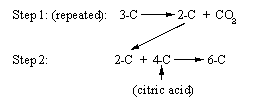
Study the figure in your text. Also during Step 1 hydrogen is being removed by a NAD coenzyme.
Step 1 expanded: NAD + 3-C ----> 2-C + NADH + CO2
This NADH will be converted into 3 ATP
(Krebs Cycle NADH form 3
ATP per molecule in the cytochorme
system instead of 2 as in glycolysis).
In the second step, this two-carbon molecule joins with a four
carbon oxaloacaetic acid (OAA) to form a citric acid molecule.
The product of Step 2 is a molecule which is six carbons long.
Step 2: 4-C + 2-C -----> 6-C
It may seem strange that the second step in the oxidative respiration of pyruvic acid creates a longer molecule, but after you have seen the entire process, you will understand why.
In the third step the six-carbon molecule citrate is converted to isocitrate with little or no loss of biological energy.
In step four the six carbon isocitrate molecule is decarboxylated
forming a five carbon alpha-ketoglutaric acid and carbon dioxide.
Also more hydrogen is pulled off by a NAD coenzymecule. This is an
example of a dehydrogenation reaction, which is the removal of hydrogen
from a molecule.
You should remember that after a dehydrogenation reaction, the hydrogen atoms move to other atoms or molecules which are known as _____.
Answer: Hydrogen acceptors such as NADH, FADH2.
If oxygen is present, these hydrogen acceptors can move the the cytochrome system (CETS) where oxygen will be used and energy acquired by the hydrogen acceptors is transferred into ATP molecules.
Step 4: NAD + 6-C ---> 5-C + CO2 + NADH
Step 5: ADP + NAD + 5-C ---> 4-C + CO2 + NADH + ATP
The production of the hydrogen atoms in this step is important to the respiration process. Click the statements which correctly explain the importance of the hydrogen atoms. Each hydrogen atom produced has the potential to:
The next two reactions, Steps 6 and 7, are important because they both involve the production of hydrogen atoms by the process of dehydrogenation. Step six involves succinate(4-C) being converted into fumaric acid (4-C). However during this step the hydrogen acceptor is a different coenzyme, FAD. The FADH2 molecule formed can also have its enegy transferred into ATP by moving to the cytochrome system. However, only two ATP molecules will be formed for each FADH2 molecule entering the CETS.Step 6: FAD + 4-C ---> 4-C + FADH2
Between step six and seven fumaric acid in converted into
malic acid with no biological energy being formed.
Step seven involves malic acid being converted into oxaloacetic acid with hydrogen being removed by the coenzyme NAD.
Step 7: NAD + 4-C ---> 4-C + NADH
At this point it is important that you know the name of the four-carbon compound produced in Step 7. It is oxaloacetic acid.
Look back to the Step 2 reaction and examine the chemical reaction which took place at that step.
Why is the identity of oxaloacetic acid produced in Step 7 so important?
Answer: Oxaloacetic acid is the same compound which reacted with acetyl Co. A in Step 2. This seems to indicate that the process of oxidative respiration is cyclic in nature.
9. The following diagram summarizes the seven steps in the oxidation of pyruvic acid presented thus far. Study the figure indicated by E-10.
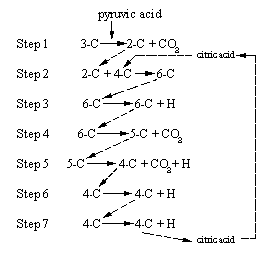 Has
the pyruvic acid been used up yet by the series of reactions? To answer
this question, one a can use a "bookkeeping approach" of counting atoms
to examine the progress of the reactions.
Has
the pyruvic acid been used up yet by the series of reactions? To answer
this question, one a can use a "bookkeeping approach" of counting atoms
to examine the progress of the reactions.
Pyruvic acid is a three-carbon compound with the chemical formula C3H4O3 One molecule of pyruvic acid enters the series of reactions at Step 1. The only other reactant shown entering the oxidative respiration process is a molecule of citric acid, which enters the reactions at Step 2. But a molecule of citric acid is produced by the reactions in Step 7. What can you say about the citric acid in the oxidative respiration of pyruvic acid at the conclusion of Step 7 of the process? (Click one.)
- a. Citric acid has been used up in the process.
- b. Citric acid has been created by the process.
- c. There has been no net change in the amount of citric acid.
Since the citric acid is regenerated in the process, we need to focus our attention on the other reactant (pyruvic acid) and the products of the seven reactions. Study the figure indicated by E-11.
Three carbon atoms enter the reactions in a molecule of pyruvic acid. Three carbon atoms leave the reactions in molecule of carbon dioxide. It is clear the pyruvic acid molecule supplies all of the carbon and hydrogen necessary for the reactions. You can see from the bookkeeping of atoms that pyruvic acid has been completely broken down (all atoms have been transferred to product substances) by Step 7 of the process. The carbon and oxygen atoms have been given off to the environment in the form of carbon dioxide. The hydrogen atoms have been freed from the pyruvic acid molecule. What do you predict is their eventual fate in oxidative respiration?
Answer: They will be oxidized to form water, since oxygen is available for the process. The reaction will liberate a lot of energy. This occurs in the cytochrome electron transport system which will be investigated on the next web page.
In cellular respiration, glucose is converted into pyruvic acid molecules (glycolysis) with an accompanying release of energy. Then the pyruvic acid molecules are further broken down through a cycle of chemical reactions (Krebs Cycle). This set of reactions is usually called the citric acid cycle, but it may also be termed the Krebs Cycle or tricarboxylic acid cycle. The illustration below demonstrates the cyclic nature of the process, as the citric acid enters the reaction in the second step and is regenerated in the seventh step.
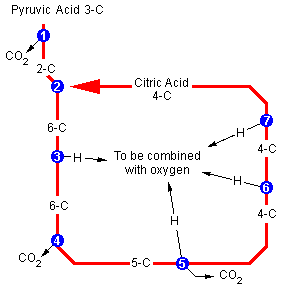
Examine the illustration carefully. It shows starting compounds (pyruvic
acid and citric acid), intermediary carbon compounds (in notation form),
waste products given off (carbon dioxide escaping to the outside), and
energy-potential products (hydrogen atoms shown in the center of the illustration).
Now that you have completed your "road map" for the reactions which occur in the Krebs Cycle, determine what goes into and out of the input/output box. This is the material you will be evaluated on during testing.
input/output box
(write in your notes and learn)
Organic Molecules - Input: pyruvic acid
Output: 3 carbon dioxide
molecules and 2 waters per pyruvic acid
Energy Output -
ATP ( 1 ATP per cycle formed directly by substrate phosphorylation)
NADH (4 per cycle formed which may be converted into 3 ATP per
NADH thus a total of twelve ATP molecules may be formed by
these coenzymes)
FADH2 (1 formed which may be converted into
2 ATP per
FADH2 thus a total of two ATP molecules may be formed
by this
coenzyme)
Kreb cycle produces 1 ATP directly, 12 through NADH, and 2 through FADH2 total of 15 ATP per Kreb cycle. There are two Kreb cycles per glucose, thus a total of 30 ATP may be produced by the Kreb cycle reactions per glucose of cellular respiration.
Substrate phosphorylation refers to the ATP made directly from a substrate.
Oxidative phosphorylation refers to the ATP synthesized through the
NADH
or FADH2 utilizing the cytochrome electrons
system (CETS).
During the process of aerobic carbohydrate metabolism, glucose molecules are completely converted into carbon dioxide and water. Thirty-six ATP molecules are formed for each glucose molecule which is completely metabolized. Six of the ATP molecules are from glycolysis and thirty are from the two Krebs Cycle.
If no oxygen is available to the cell, it can still process sugar molecules
and derive some energy from them, but the process is not nearly so efficient
as when oxygen is present. This process is called fermentation. The next
web page presents the picture of the cytochrome system where NADH and FADH
release energy to form ATP. Oxygen will be used to combine with excess
hydrogen ions formed during these reactions to form water.
When hydrogen atoms liberate the last bit of energy and join the oxygen atom, the oxidative respiration process is complete. One glucose molecule has yielded all its available energy to the cell in the process of respiration.
The diagram below illustrates the overall energy extraction process.
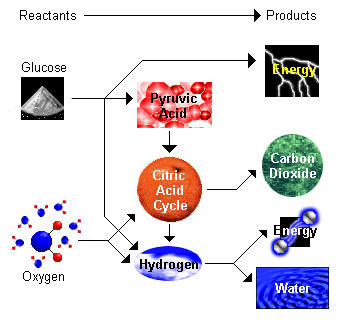
To help you better understand oxidative respiration and carbon, hydrate metabolism, it is necessary to do some more bookkeeping. Let's find out how much energy is liberated as one glucose molecule is oxidized to produce water and carbon dioxide. Here is a slightly more detailed account of carbohydrate metabolism. Look at the following diagram.
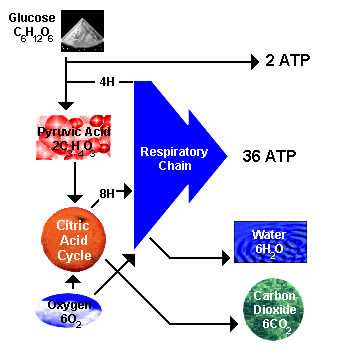
When pyruvic acid goes through the Krebs cycle, how many hydrogen atoms linked to NAD and FAD are liberated from the molecules?
Each hydrogen atom that progresses down the respiratory chain produces enough energy to drive the production of an average of three ATP molecules.A total of twelve hydrogen atoms pass down the respiratory chain and produce a total of thirty-six ATP molecules of stored energy.
The total number of ATP's produced from the breakdown of one sugar molecule is (click one):
- a. two
- b. thirty-six
- c. thirty-eight
- This is the end of lesson six . Click here to go back to the home page and lesson seven Respiration- Cytochrome Electron Transport System . click
Last modified October 29, 1997.